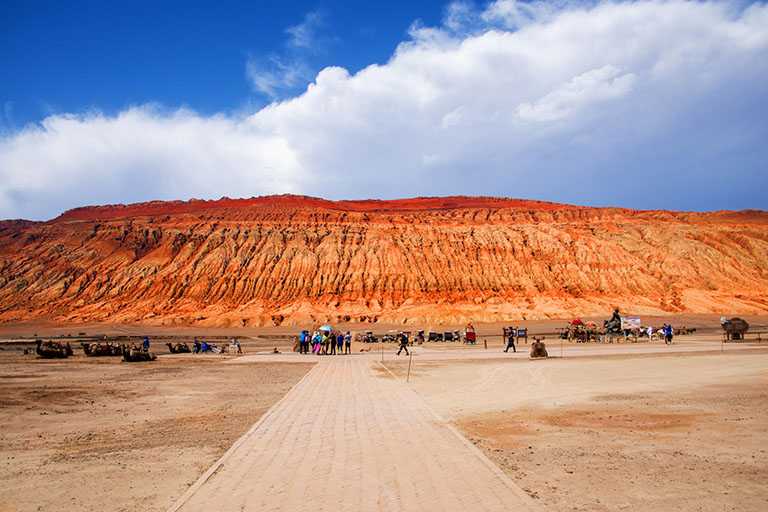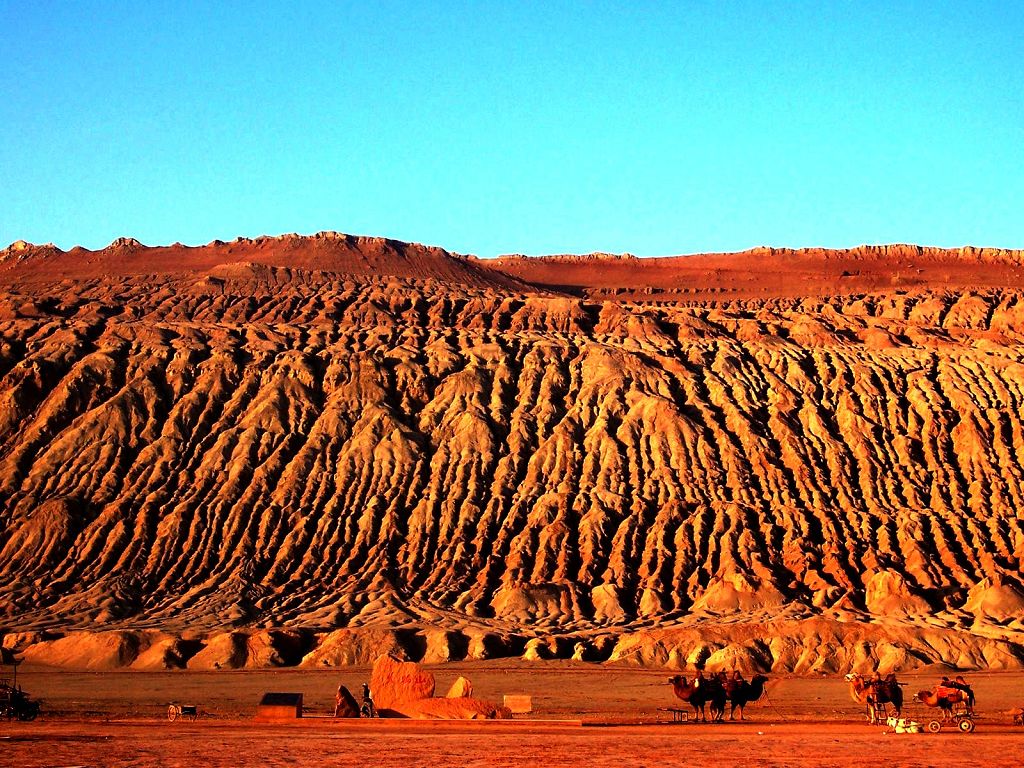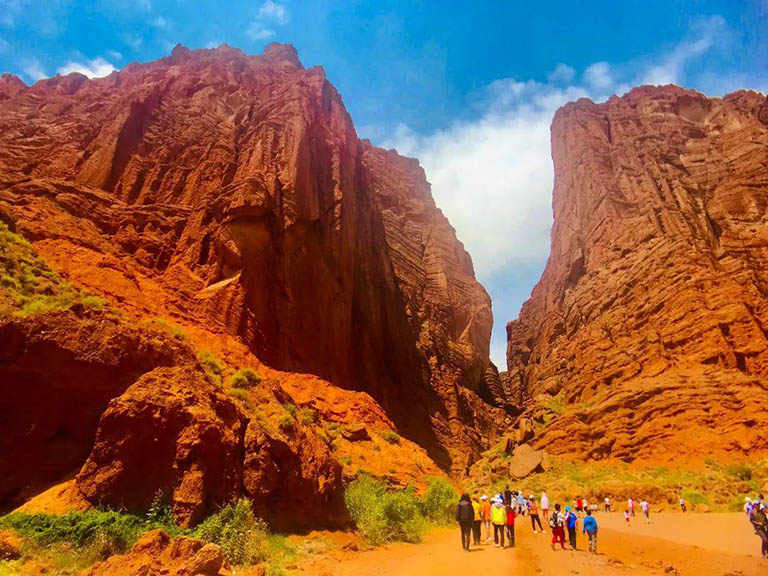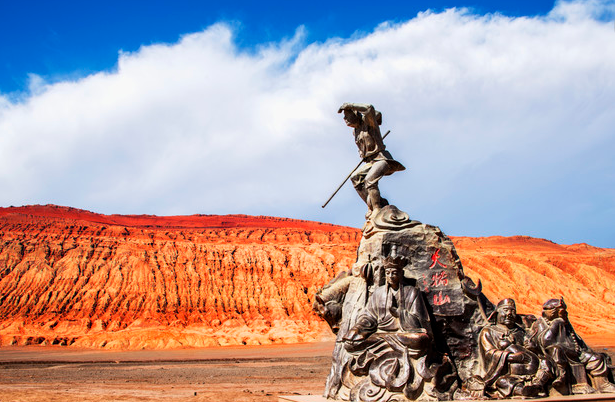Experience the Magic of Flaming Mountain: A Turpan Travel Guide

An Essential Guide to Visiting Flaming Mountain Turpan
Nestled in the heart of the Turpan Basin, the Flaming Mountains (Huoyan Shan) rise dramatically from the arid landscape, their fiery hues igniting the imagination of visitors from around the globe. Renowned for their striking reddish-brown sandstone formations, these mountains are not only a geological wonder but also steeped in literary lore, immortalized in the classic Chinese novel “Journey to the West.” According to legend, the mischievous Monkey King inadvertently created this scorching landscape, scattering charcoal across the region when he toppled a celestial furnace.
As you stand before these majestic peaks, it’s hard not to feel a sense of awe at the beauty and harshness of this desert environment. The Flaming Mountains offer a unique opportunity to explore a surreal world where the sun beats down relentlessly, creating an otherworldly atmosphere. From camel rides to fascinating geological displays, the area is rich with activities that invite you to immerse yourself in both nature and culture. However, be prepared for crowds, as this popular destination attracts tourists eager to witness its stunning vistas and snap the quintessential selfie against the fiery backdrop.
Whether you’re a history buff, a nature lover, or simply in search of a memorable adventure, the Flaming Mountains promise an experience like no other. As you embark on your journey to this captivating locale, prepare to be enchanted by its legendary past and breathtaking scenery.
In This Guide
- An Essential Guide to Visiting Flaming Mountain Turpan
- The Rich History and Legends of Flaming Mountain Turpan
- Main Highlights: What You Absolutely Can’t Miss
- Planning Your Visit: A Practical Guide
- Tickets: Prices, Booking, and Tips
- How to Get There: A Complete Transportation Guide
- Local Cuisine and Accommodation Nearby
- Frequently Asked Questions
- Final Thoughts on Your Trip
The Rich History and Legends of Flaming Mountain Turpan
Nestled in the heart of the Turpan Basin, the Flaming Mountain, or Huoyan Shan, is a geological wonder that has captivated travelers and locals alike for centuries. Its striking reddish-brown sandstone formations rise dramatically from the arid landscape, creating a surreal and mesmerizing sight that feels almost otherworldly.
The history of Flaming Mountain is intertwined with the rich cultural tapestry of the region, notably through the lens of Chinese folklore. One of the most famous tales associated with this dramatic landscape comes from the classic novel Journey to the West, written by Wu Cheng’en during the Ming Dynasty. In this beloved story, the fiery peaks of the Flaming Mountain are said to have originated from a celestial mishap involving the Monkey King, Sun Wukong. According to legend, after causing chaos in the Heavenly Palace, the Monkey King inadvertently knocked over a furnace used for crafting elixirs of immortality, resulting in hot coals raining down upon the earth. This fantastical event is believed to have given rise to the Flaming Mountain, forever linking it to the playful misadventures of the Monkey King and his companions.
Beyond its literary fame, Flaming Mountain is also steeped in the natural history of the region. The unique geological formations are a result of millions of years of erosion, revealing layers of sediment that tell the story of a once-vibrant landscape now transformed into a harsh, desert-like environment. Visitors often describe the feeling of being transported to another world, with the fiery hues of the mountains contrasting sharply against the bright blue sky.
For those venturing to this remarkable site, the experience is enhanced by a variety of attractions that celebrate its cultural significance. Statues of characters from Journey to the West, such as the Iron Fan Princess and the Bull Demon King, can be found scattered throughout the area, inviting tourists to engage with the legendary tales in a tangible way. The site also features the largest thermometer in the world, humorously designed to resemble the Monkey King’s magical staff, Ruyi Jingu Bang, which not only serves as a quirky photo opportunity but also highlights the extreme temperatures often recorded in this region.
While the Flaming Mountain may attract large crowds, particularly during peak seasons, its allure remains undiminished. The best time to appreciate its beauty is during the golden hours of sunrise or sunset when the mountains seem to glow with an ethereal light, casting long shadows over the landscape. Whether you are a history enthusiast, a fan of folklore, or simply an admirer of natural beauty, the Flaming Mountain offers a unique glimpse into the rich history and legends of Turpan, making it a must-visit destination on your travels through Xinjiang.

Flaming Mountain Turpan.
Main Highlights: What You Absolutely Can’t Miss
When visiting the Flaming Mountains (Huoyan Shan) in Turpan, there are several highlights that you absolutely cannot miss. This stunning geological wonder is not only a feast for the eyes but also steeped in rich cultural heritage and lore. Here’s a detailed guide to ensure you make the most of your experience!
1. The Iconic Flaming Mountains
The main attraction, of course, is the Flaming Mountains themselves. These striking red sandstone formations are particularly vibrant under the midday sun, creating an otherworldly landscape that looks as if it’s ablaze. The mountains are named after their intense colors, which appear to flicker and glow, especially during the hottest parts of the day. Don’t forget your camera—this is a sight you’ll want to capture!
2. Legend of “Journey to the West”
The Flaming Mountains are not just a natural wonder; they are deeply rooted in Chinese mythology, particularly the classic novel “Journey to the West.” According to the tale, the Monkey King caused the mountains to catch fire while battling a demon. Understanding this context adds a layer of intrigue to your visit. Be sure to check out the informational displays at the visitor center that explain the legend and its characters, including the famous Monkey King.
3. World’s Largest Thermometer
As you explore the area, keep an eye out for the giant thermometer that humorously resembles the Monkey King’s magical weapon, the Ruyi Jingu Bang. This quirky landmark not only serves as a photo opportunity but also gives you a sense of just how hot this region can get—often exceeding 48 degrees Celsius (118 degrees Fahrenheit). It’s a fun spot to snap a selfie!
4. Cultural Statues and Activities
Around the visitor center, you’ll find life-sized statues of characters from “Journey to the West,” including the Monkey King, Bull Demon King, and Iron Fan Princess. These are popular spots for tourists looking to pose for pictures. Additionally, there are various activities available, such as camel rides and ATV rentals. While some visitors may find these attractions a bit commercialized, they do add a fun element to your adventure.
5. Scenic Views and Hiking Trails
For those looking to immerse themselves in the landscape, several trails offer stunning views of the Flaming Mountains and surrounding desert. The hiking experience can be intense due to the heat, so it’s best to start early in the day or later in the afternoon. Ensure you have plenty of water and sunscreen, as the sun can be unforgiving.
6. Visitor Center Insights
The visitor center provides a wealth of information about the geology of the Flaming Mountains and their significance in local culture. While some reviews mention that it can feel overly commercialized, the center does offer educational displays that enhance your understanding of the region’s unique environment.
7. Nearby Attractions
Consider combining your trip to the Flaming Mountains with visits to nearby sites such as the Bezeklik Thousand Buddha Caves and the Ancient City of Gaochang. These attractions provide additional context to the history and culture of the Turpan region, making for a well-rounded exploration of this fascinating area.
8. Photography Tips
Due to the popularity of this site, it can get quite crowded. If you’re hoping to capture the mountains without the crowds, try visiting during off-peak hours or explore less popular viewpoints. Early morning or late afternoon light can also enhance your photographs, casting beautiful shadows and bringing out the rich colors of the landscape.
In summary, the Flaming Mountains in Turpan are a must-see destination that combines natural beauty with cultural significance. Whether you’re drawn by the stunning landscapes, the rich stories, or the fun activities, you’re sure to leave with unforgettable memories. Happy exploring!

Flaming Mountain Turpan.
Planning Your Visit: A Practical Guide
Visiting the Flaming Mountain in Turpan is a unique experience that combines stunning natural beauty with cultural significance. Here’s everything you need to know to make the most of your trip to this captivating destination.
Getting There
The Flaming Mountain, also known as Huoyan Shan, is located in the Turpan Basin, about 30 kilometers from the city of Turpan. The easiest way to reach the mountains is by renting a car, which allows for flexibility in your schedule. Alternatively, you can take public transportation from Turpan:
-
By Bus: Head to the Turpan bus station and take a bus to Shan Shan. Be prepared to get off halfway and look for passing vehicles for your return trip, as there may not be frequent buses.
-
By Tour: Many local tour companies offer day trips that include the Flaming Mountain along with other attractions in the area.
Best Time to Visit
To enjoy the Flaming Mountain without suffering from extreme heat, it’s best to visit in spring (April to June) or autumn (September to November). During these seasons, temperatures are milder, making for a more pleasant experience. Summer can be brutally hot, reaching up to 48 degrees Celsius (118 degrees Fahrenheit), so if you visit during this time, ensure you stay hydrated and wear appropriate sun protection.
Opening Hours
The Flaming Mountain is open daily from 10:00 AM to 7:00 PM. Keep in mind that visiting early in the morning or later in the afternoon may help you avoid the crowds and capture better photos.
Entrance Fee
Admission to the Flaming Mountain is typically around 40 RMB per person. This fee grants you access to the site, where you can explore various viewpoints and take in the breathtaking scenery.
What to Expect
As you approach the Flaming Mountain, you’ll be greeted with striking reddish-brown sandstone formations that appear to glow under the sun. The site is steeped in folklore, particularly the famous Chinese novel “Journey to the West,” which tells the story of the Monkey King. Look out for the giant thermometer resembling the Monkey King’s magical staff, which adds a fun element to the visit.
While the mountains themselves are visually impressive, be prepared for a bustling atmosphere, as many visitors come to enjoy the landscape, take selfies, and participate in various activities. Camel rides and themed attractions inspired by “Journey to the West” can contribute to the lively environment, but they may also detract from the serene beauty of the mountains.
Tips for a Great Visit
-
Photography: If you’re keen on capturing the perfect shot, try to visit during off-peak hours. The site can get crowded, making it challenging to take unobstructed photos.
-
Hydration and Sun Protection: Bring plenty of water and sunscreen, as the sun can be intense, especially in the summer months. Wearing a wide-brimmed hat and lightweight clothing can also help keep you cool.
-
Combine Attractions: Consider pairing your visit to the Flaming Mountain with nearby sites like the Bezeklik Thousand Buddha Caves or the Jiaohe Ruins for a fuller experience of Turpan’s rich history and culture.
-
Local Cuisine: After your exploration, treat yourself to authentic local dishes at nearby restaurants. Turpan is known for its delicious lamb dishes and fresh fruits, particularly grapes.
Conclusion
A visit to the Flaming Mountain offers a fascinating glimpse into both nature and Chinese mythology. With proper planning, you can enjoy this stunning landscape while immersing yourself in the rich stories that surround it. Whether you’re a photography enthusiast or simply looking to take in the sights, the Flaming Mountain is sure to leave a lasting impression.

Flaming Mountain Turpan.
Tickets: Prices, Booking, and Tips
When planning your visit to the iconic Flaming Mountains in Turpan, it’s essential to know the ticketing details and some handy tips to enhance your experience.
Ticket Information
-
Entry Fee: A standard ticket to the Flaming Mountains is priced at 40 RMB per person. This fee grants you access to the scenic views and the visitor center, where you can learn about the fascinating legends linked to this unique landscape.
-
Opening Hours: The Flaming Mountains are open daily from 10:00 AM to 7:00 PM. It’s advisable to arrive early in the day to avoid the peak tourist crowds, particularly during the hotter months when temperatures can soar.
Booking Tips
-
Advance Booking: While tickets can typically be purchased at the entrance, it’s wise to check if online booking options are available, especially during peak travel seasons. This can save you time and guarantee entry.
-
Guided Tours: Consider joining a guided tour that includes the Flaming Mountains as part of a broader itinerary. Many tours offer flexible options, from private day trips to extensive Silk Road adventures, which can enhance your experience with local insights and reduce the hassle of transport logistics.
-
Transportation: If you’re traveling independently, renting a car is often the most convenient way to explore Turpan and its surroundings, allowing you to visit the Flaming Mountains at your own pace.
Experience Enhancements
-
Timing Your Visit: To capture the stunning red hues of the mountains, plan your visit on a sunny day. Early morning or late afternoon light provides the best photographic opportunities, while also helping you avoid the midday heat.
-
Stay Hydrated: Given the extreme temperatures, especially in summer, be sure to bring plenty of water and wear sunscreen. The Flaming Mountains are known for their barren landscape and lack of shade.
-
Expect Crowds: The Flaming Mountains can get quite crowded with tourists, especially those familiar with the “Journey to the West” legend. Arriving early or visiting on weekdays may offer a more peaceful experience.
By keeping these tips in mind, your visit to the Flaming Mountains can be both enjoyable and memorable, allowing you to appreciate the breathtaking scenery and rich cultural heritage of this unique natural wonder.
How to Get There: A Complete Transportation Guide
Getting to the Flaming Mountains in Turpan is an adventure that combines stunning desert landscapes with rich cultural history. Here’s a comprehensive guide to help you navigate your journey to this iconic destination in Xinjiang, China.
Arriving by Air
The closest airport to Turpan is Turpan Jiaohe Airport (TLQ), which is about 20 kilometers (12 miles) from the city center. Although the airport has limited domestic flights, it connects to major cities in China, including Urumqi, the regional capital.
- Flight Options: From major cities like Beijing, Shanghai, or Urumqi, you can book a flight to Turpan. Check local airlines for schedules and availability.
- Airport Transfers: Upon arrival, taxis are readily available outside the terminal. A taxi ride to the city center will take approximately 30 minutes and cost around 50-70 RMB.
Getting to Turpan from Urumqi
If you fly into Urumqi Diwopu International Airport (URC), you have a couple of options to reach Turpan, which is about 180 kilometers (112 miles) away:
- Train:
- Duration: Approximately 2-3 hours.
- Frequency: Trains run frequently throughout the day.
- Cost: Tickets range from 30 to 80 RMB depending on the class.
-
How to Book: You can purchase tickets at the train station or online through various booking platforms.
-
Bus:
- Duration: Around 3-4 hours.
- Location: Buses leave from the Urumqi Long-distance Bus Station.
- Cost: Tickets typically cost between 50 to 70 RMB.
- Tip: Ensure to check the bus schedule ahead of your trip, as they may vary.
Local Transportation in Turpan
Once you arrive in Turpan, you can use the following methods to reach the Flaming Mountains:
- Taxi:
-
Taxis are widely available and provide a convenient option to reach the Flaming Mountains. The ride from the city center to the site will take about 30 minutes and cost approximately 50-80 RMB.
-
Public Bus:
- There are local buses that connect Turpan with the Flaming Mountains. Look for buses heading to Shanshan, and ask the driver to drop you at the Flaming Mountains entrance.
-
Cost: A bus ticket typically costs around 5 RMB.
-
Rental Car:
- For a more flexible option, consider renting a car. This is ideal if you plan to explore multiple attractions in and around Turpan, such as the Karez irrigation system and the ancient city ruins.
-
Cost: Rental prices vary, but you can expect to pay around 320 RMB per day for a small vehicle.
-
Private Tours:
- Many travelers opt for private tours that include transportation to the Flaming Mountains along with other local attractions. This can be a great way to gain insights from a guide and avoid the hassle of navigation.
- Prices for private tours typically start around 200 RMB per person, depending on the itinerary.
Tips for Visiting Flaming Mountains
- Plan Your Visit: The Flaming Mountains can get extremely hot, especially in summer months. Aim to visit early in the morning or later in the afternoon to avoid the peak heat of the day.
- Entrance Fee: Be prepared to pay an entrance fee of around 40 RMB.
- Crowd Control: Expect large crowds, particularly during peak tourist seasons. If you’re looking for a quieter experience, consider visiting on weekdays.
- Accommodation: Booking accommodation in advance is advisable, especially during the tourist season. Options range from budget hostels to comfortable hotels in Turpan.
By following this guide, you’ll be well-prepared to embark on your journey to the Flaming Mountains, a must-see marvel in the heart of Xinjiang’s diverse landscape. Enjoy the stunning views and the unique cultural experiences that await you!

Flaming Mountain Turpan.
Local Cuisine and Accommodation Nearby
When visiting the breathtaking Flaming Mountains in Turpan, indulging in the local cuisine and finding comfortable accommodation can elevate your experience. The region’s unique blend of cultures is reflected in its flavorful dishes and welcoming lodgings.
Local Cuisine
Turpan is known for its rich culinary heritage, influenced by both Uyghur and Han Chinese traditions. Here are some must-try dishes:
-
Dapanji (Big Plate Chicken): This hearty dish features tender chicken pieces stewed with potatoes and peppers, all served in a spicy, aromatic sauce. It’s a favorite among locals and is often enjoyed with hand-pulled noodles or rice.
-
Naan Bread: A staple in Uyghur cuisine, this fluffy, oven-baked flatbread is perfect for scooping up stews or enjoying on its own. Be sure to try it fresh from a local bakery!
-
Laghman: A delicious noodle dish, Laghman is made with hand-pulled noodles topped with stir-fried vegetables and meat, often garnished with a spicy sauce. It’s a comforting and filling meal that reflects the region’s nomadic roots.
-
Kebabs: Grilled skewers of marinated meat, usually lamb or chicken, are a popular street food in Turpan. Often seasoned with cumin and chili, these savory bites are a perfect snack while exploring the area.
-
Grapes and Raisins: Turpan is famous for its sweet grapes, thanks to the region’s arid climate. Don’t miss the chance to sample fresh grapes or dried raisins, which are often sold at local markets.
Accommodation Nearby
To rest after a day of exploring the Flaming Mountains, consider these accommodation options that offer comfort and convenience:
-
Turpan Hotel: Located in the heart of Turpan, this hotel provides comfortable rooms along with modern amenities. Its proximity to local attractions makes it a convenient base for travelers. Enjoy a complimentary breakfast featuring local dishes to start your day right.
-
Nirvana Hotel: This charming hotel combines traditional Uyghur decor with contemporary comforts. With spacious rooms and a lovely garden, it’s a great place to unwind. The staff is known for their warm hospitality and can assist with arranging tours to nearby attractions.
-
Turpan Huozhou Hotel: Offering a blend of local culture and modern conveniences, this hotel features well-appointed rooms and a restaurant serving authentic Uyghur cuisine. It’s a short drive from the Flaming Mountains, making it an ideal choice for those looking to explore the area.
-
Grape Valley Guesthouse: For a more rustic experience, consider staying in a guesthouse in Grape Valley. Here, you can enjoy stunning views of the surrounding vineyards and mountains while savoring home-cooked meals made from fresh local ingredients.
Exploring the Flaming Mountains is not just about witnessing the stunning landscape but also about immersing yourself in the local culture through its food and hospitality. Make sure to indulge in the flavors of Turpan and enjoy the warmth of its accommodations as part of your adventure!

Flaming Mountain Turpan.
Frequently Asked Questions
Frequently Asked Questions about Flaming Mountain Turpan
1. What are the opening hours for Flaming Mountain?
Flaming Mountain is open daily from 10:00 AM to 7:00 PM. Be sure to check for any seasonal changes in hours before your visit.
2. How much is the entrance fee?
The entrance fee to Flaming Mountain is 40 RMB per person. This fee grants you access to the viewing areas and the visitor center.
3. What is the best time to visit Flaming Mountain?
The best time to visit is during the cooler months, from late spring to early autumn, when temperatures are more bearable. Early mornings or late afternoons can provide a more pleasant experience, avoiding the heat of midday.
4. Are there any guided tours available?
Yes, there are several guided tours available that include Flaming Mountain as part of a broader exploration of Turpan. These tours often provide insights into the area’s history and geology, as well as the famous legends associated with the mountains.
5. What should I wear when visiting Flaming Mountain?
Dress in lightweight, breathable clothing suitable for hot weather. A wide-brimmed hat, sunglasses, and sunscreen are highly recommended to protect against the intense sun. Sturdy shoes are also advisable if you plan to explore the area.
6. Can I take photos at Flaming Mountain?
Yes, you can take photos, but be prepared for crowds, especially during peak tourist seasons. For the best shots, try to visit early in the morning or later in the afternoon when fewer tourists are around.
7. What amenities are available at Flaming Mountain?
There is a visitor center with information about the geology and legends of Flaming Mountain. Additionally, you’ll find restrooms and some basic amenities, but dining options are limited, so it’s a good idea to bring snacks and water.
8. Are there any activities besides sightseeing?
Yes! Visitors can enjoy camel rides, donkey rides, and even 4WD tours in the area. However, keep in mind that these activities can be quite hot and strenuous, so stay hydrated and take breaks as needed.
Final Thoughts on Your Trip
As your adventure at the Flaming Mountains comes to a close, take a moment to reflect on the unique blend of natural beauty and cultural significance that this extraordinary landscape offers. The striking red sandstone peaks, bathed in the glow of the setting sun, serve as a reminder of the region’s mythical past, steeped in legends from the famed “Journey to the West.” While the crowds may sometimes distract from the serene beauty of the mountains, the vibrant energy of fellow travelers and the whimsical touches of local culture add an unforgettable layer to your experience.
Whether you chose to explore the area on foot, capture stunning photographs, or simply soak in the magnificent views, the Flaming Mountains leave an indelible mark on every visitor. Embrace the heat, the history, and the stories that echo through this ancient landscape. As you depart Turpan, carry with you the memories of this fiery wonderland and the spirit of adventure that it ignites within. Safe travels, and may your journeys lead you to many more breathtaking destinations!